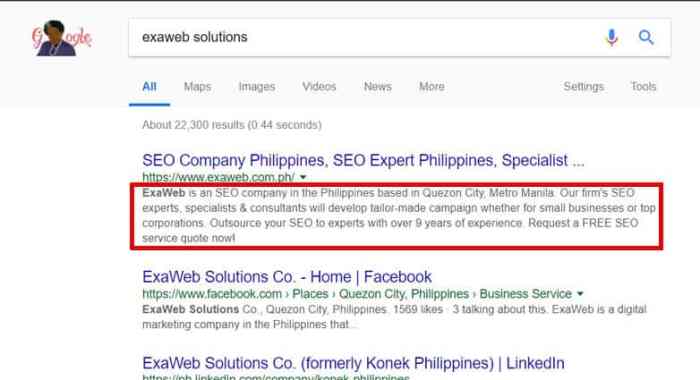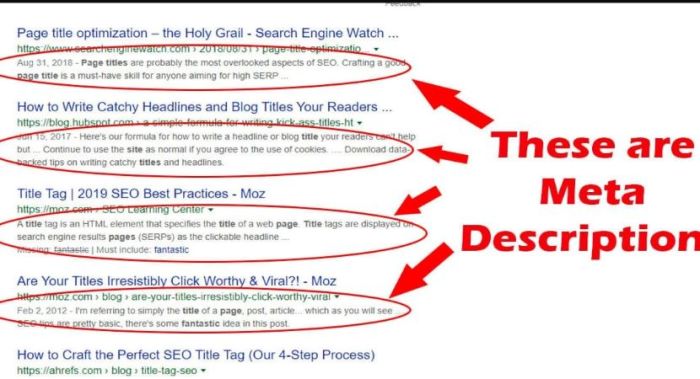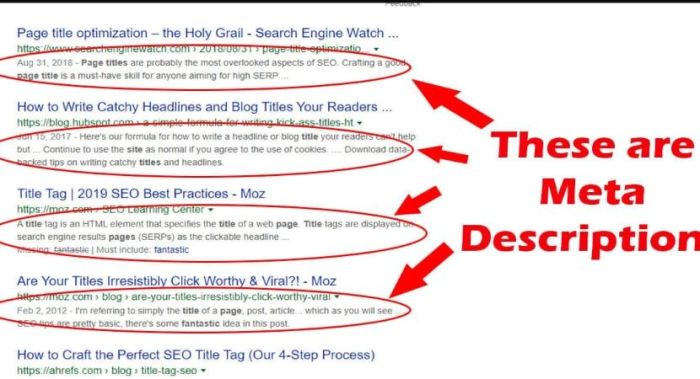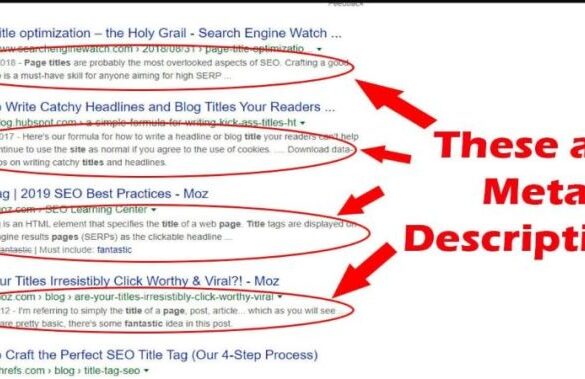Why Google rewrites your meta description? This comprehensive guide delves into the fascinating world of meta descriptions and how Google’s algorithm handles them. Understanding this process is crucial for optimizing your search visibility and improving user experience. We’ll explore everything from the basics of meta descriptions to the technical considerations that can trigger Google’s rewriting actions.
From understanding the fundamental function of meta descriptions in to analyzing Google’s algorithm and how it interprets these descriptions, this article offers a detailed look at the factors involved. We’ll uncover the reasons behind Google’s rewriting, the impact on search visibility, and strategies for avoiding unwanted changes. Plus, user experience and technical aspects will be examined to gain a holistic understanding.
Understanding Meta Descriptions
Meta descriptions are concise summaries of web pages that appear in search engine results pages (SERPs). They play a crucial role in attracting users to click on your website link amidst the competition. Understanding their function and how search engines utilize them is key to optimizing your content for improved visibility and increased organic traffic.Search engines, like Google, use meta descriptions to provide users with a preview of the page’s content.
They are displayed beneath the page title in the search results, acting as a crucial snippet that influences a user’s decision to click on your listing. A compelling meta description can significantly boost click-through rates, while a poorly crafted one can lead to lower visibility and missed opportunities.
Function in Search Engine Optimization
Meta descriptions are a vital component of . They are a concise summary of the page’s content, displayed in search engine results. A well-crafted description can increase click-through rates (CTR) from search results, leading to more traffic to your website.
How Search Engines Use Meta Descriptions
Search engines utilize meta descriptions to present a snapshot of the page’s content to users. They don’t always use the exact meta description provided. Sometimes, they extract relevant phrases and text from the page’s content itself to create a more informative description. However, the meta description still serves as a valuable guide for the search engine’s algorithm.
Relationship Between Meta Descriptions and Click-Through Rates (CTR)
The relationship between meta descriptions and click-through rates is undeniable. Compelling descriptions that accurately reflect the page’s content are more likely to entice users to click. A well-written meta description clearly communicates the value proposition of the page to the user. This, in turn, often translates into higher CTRs and increased organic traffic.
Best Practices for Crafting Effective Meta Descriptions
Crafting effective meta descriptions requires a thoughtful approach. Here are some key best practices:
- Keep it concise: Aim for 150-160 characters or less to ensure the entire description displays fully in search results. Conciseness is crucial for clarity and user engagement.
- Be accurate and relevant: Reflect the page’s content accurately. Avoid misleading or vague language. Users should understand exactly what they’ll find on the page from the description.
- Include relevant s: Incorporate relevant s naturally to signal the page’s topic to search engines. This can help improve visibility for related searches.
- Emphasize the unique value proposition: Highlight what makes your page stand out from competitors. What unique benefit does the page offer?
- Use compelling language: Employ a persuasive tone to encourage clicks. Use action verbs and words that evoke interest and a sense of urgency.
Short vs. Long Meta Descriptions
The optimal length for a meta description remains a subject of discussion. However, the impact on CTR varies significantly depending on the specific case.
| Description Length | Impact on CTR | Explanation |
|---|---|---|
| Short (under 150 characters) | Potentially higher CTR, especially if highly compelling | Short descriptions can be more impactful when they effectively capture user attention. They may display completely in search results, leading to a greater likelihood of being noticed. |
| Long (over 150 characters) | Potential for higher CTR if the extra space is utilized effectively. Can lead to more detailed descriptions. | Longer descriptions allow for more detailed explanations and can entice users with a fuller picture of the page’s content. However, the full description may not always display entirely, depending on the search engine’s display settings. |
Google’s Algorithm and Meta Descriptions

Understanding how Google’s algorithm interprets meta descriptions is crucial for optimizing your website’s visibility in search results. Meta descriptions, though not a direct ranking factor, significantly impact click-through rates (CTR). A compelling meta description can entice users to click on your listing, driving more traffic to your site. Conversely, a poorly written description might lead to lower CTR, diminishing your website’s overall visibility.Google’s algorithm doesn’t directly use meta descriptions as a ranking signal in the same way it analyzes page content.
Instead, it considers meta descriptions within the context of the entire search results page. This means that while the description itself is important, Google’s evaluation is influenced by factors like the user’s search query, other search results, and even the overall user experience on the page.
Factors Influencing Meta Description Ranking
Google’s algorithm evaluates meta descriptions based on a multitude of factors. Relevance to the user’s search query is paramount. A meta description that accurately reflects the page’s content is more likely to be considered relevant. s, while not as crucial as they once were, still play a role in indicating the page’s topic. The length of the description is also considered.
Google prioritizes conciseness and clarity. A well-structured description, using clear language and avoiding overly technical jargon, is preferred. Additionally, the meta description’s accuracy in summarizing the page’s content is important. A description that accurately reflects the page’s content and topic is more likely to be considered relevant and helpful to the user.
Semantic Analysis in Meta Description Interpretation
Google’s algorithm now incorporates semantic analysis to understand the context and meaning behind meta descriptions. This means Google looks beyond simple matching to grasp the overall concept and intent of the description. For example, a meta description that uses synonyms or related terms for a will likely be interpreted as relevant even if the exact isn’t present.
This advanced interpretation allows Google to present more relevant results to users. This approach aligns with Google’s goal of providing the most helpful and informative search results possible.
Google rewrites your meta description to ensure it accurately reflects the page content and provides a relevant snippet for search results. This helps users quickly understand what a page is about, and is crucial for a strong online presence. Optimizing your Google My Business strategy google my business strategy can also indirectly impact meta descriptions, as a well-managed business profile often leads to better, more accurate descriptions generated by Google’s algorithms.
Ultimately, Google’s rewriting ensures a consistent and helpful user experience.
Handling Different Types of Meta Descriptions
Google’s algorithm treats different types of meta descriptions differently. For example, descriptions on informational pages, product pages, or blog posts will be evaluated with varying priorities. A description for a product page should focus on key features and benefits, whereas an informational page meta description should clearly state the page’s topic. The algorithm adapts to the type of content and provides tailored results accordingly.
Interpreting Variations in Meta Descriptions
Google’s algorithm may interpret variations in meta descriptions for the same page differently. This is largely due to the contextual analysis. A meta description that uses different phrasing, but maintains the same core message, may be interpreted as equally relevant. Slight variations in language, using different synonyms or sentence structures, may not impact Google’s evaluation significantly if the core message remains consistent.
However, significant discrepancies between the meta description and the page’s content may lead to a negative impact on visibility.
Google Rewriting Meta Descriptions
Understanding Google’s meta description rewriting process is crucial for optimizing your website’s search visibility. Google’s algorithms are constantly evolving, and meta descriptions are not immune to these changes. Knowing why and how Google rewrites descriptions can help you adapt your strategies and ensure your content is accurately represented in search results.Google rewrites meta descriptions to improve the user experience and ensure that search results are relevant and concise.
This often involves adapting descriptions to better match the user’s search query and the overall context of the search results page. This dynamic approach keeps search results fresh and informative.
Reasons for Google Rewriting Meta Descriptions
Google rewrites meta descriptions for several reasons, primarily to enhance user experience and provide more relevant information. These reasons include aligning descriptions with user queries, improving search result readability, and ensuring a consistent and coherent presentation of search results. Google aims to deliver the most helpful and informative results to users, and meta description rewriting is a tool in achieving that goal.
Situations Where Google Might Rewrite Meta Descriptions
Google might rewrite your meta description in various scenarios. One common situation involves inaccurate or misleading descriptions. If your meta description doesn’t accurately reflect the content of your page, Google may rewrite it to better align with the page’s content. Another situation is when the description is too short, too long, or contains irrelevant s. These situations can prompt Google to adjust the meta description to fit the optimal length and include the most relevant terms.
In cases where a meta description is overly promotional or doesn’t offer enough value to users, Google might rewrite it to be more informative and less promotional.
Impact of Rewriting on Search Visibility and User Experience, Why google rewrites your meta description
Google rewriting meta descriptions can have a significant impact on both search visibility and user experience. A rewritten meta description that accurately reflects the page’s content can improve search visibility by making your listing more appealing to search engine users. Conversely, a poorly rewritten description could hurt your visibility by appearing less relevant. The user experience is also affected.
A well-written, accurate description encourages clicks and increases engagement. Poorly rewritten descriptions might lead to lower click-through rates and a negative user experience.
Strategies for Ensuring Google Doesn’t Rewrite Your Meta Descriptions
Crafting effective meta descriptions that are less likely to be rewritten requires careful consideration. Maintaining accurate and concise descriptions that accurately reflect the page content is paramount. Avoid stuffing and instead prioritize natural language. The meta description should be informative and compelling, but not overly promotional. Use compelling language that encourages users to click.
Furthermore, continuously monitoring and analyzing your meta description performance is crucial. Tracking click-through rates and user engagement can identify potential issues and areas for improvement.
Factors Triggering Google to Rewrite Descriptions and Mitigation Strategies
Several factors can trigger Google to rewrite your meta descriptions. One key factor is the mismatch between the meta description and the page content. To mitigate this, ensure that your meta description accurately reflects the content on the page. Another factor is overly promotional descriptions. To avoid this, focus on providing value and information rather than just promoting your product or service.
Google rewrites your meta descriptions to ensure the displayed text accurately reflects the page’s content. This is crucial for search results, and a well-optimized meta description can significantly boost click-through rates. A strong meta description is key to a successful lead nurturing process, like the one you can learn about with Pardot automation lead nurturing process with pardot automation.
Ultimately, understanding how Google handles meta descriptions helps you craft compelling snippets that attract the right audience and maximize your SEO efforts.
If your description is too short or too long, Google may rewrite it. Maintaining the optimal length (around 150-160 characters) can prevent this issue. Inaccurate or misleading descriptions are another trigger. Ensure your meta description is accurate and reflects the page content. Finally, excessive use of s can lead to rewriting.
Focus on using s naturally within the description.
Meta Description Issues and Potential Fixes
| Meta Description Issue | Potential Fix |
|---|---|
| Inaccurate Description | Ensure the meta description accurately reflects the page content. |
| Too Short/Too Long | Maintain the optimal length (around 150-160 characters). |
| Overly Promotional | Focus on providing value and information. |
| Mismatched with Page Content | Rewrite the meta description to accurately reflect the page content. |
| Excessive Stuffing | Use s naturally and avoid excessive repetition. |
User Experience and Meta Descriptions
Meta descriptions are more than just snippets of text; they’re a critical link between your website and potential users. A well-crafted meta description can entice clicks, while a poorly written one can drive users away, negatively impacting your search engine rankings and overall user experience. Understanding the connection between meta descriptions and user experience is paramount for maximizing the effectiveness of your strategy.User experience (UX) is directly tied to how easily and effectively users can find and interact with the information they seek on your website.
Meta descriptions, being the first impression many users have of your page, play a significant role in this initial perception. If the meta description doesn’t accurately reflect the page’s content or fails to address the user’s search query, they may be less likely to click, leading to a poor user experience and, ultimately, decreased conversion rates.
The Influence of User Behavior on Meta Descriptions
User behavior, such as click-through rates (CTRs) and bounce rates, provides valuable feedback on how effective a meta description is. Google analyzes these metrics, along with other signals, to understand if a meta description is truly engaging and relevant to the user’s search intent. A high CTR suggests the description accurately reflects the page content, while a low CTR indicates a disconnect, prompting Google to adjust the meta description accordingly.
This adjustment may involve rewriting it to better match user search queries or refine the language to be more compelling. A significant bounce rate from a specific meta description indicates a mismatch between what the user expected to find and the actual content, leading Google to refine the description to better align with the user’s search query.
Characteristics of Compelling Meta Descriptions
Compelling meta descriptions resonate with users and encourage clicks. These descriptions should be concise, clear, and accurately reflect the page’s content. s relevant to the user’s search query should be strategically incorporated, but the description should also sound natural and avoid stuffing. A good meta description is a mini-summary of the page content. Including a clear call to action can further entice clicks.
Examples include phrases like “Learn more,” “Shop now,” or “Discover more.”
Correlation Between Meta Descriptions and Bounce Rates
A high bounce rate from a particular page often suggests a mismatch between the user’s expectations, as presented by the meta description, and the actual content of the page. If users click on a link expecting one thing and find something different, they are more likely to leave quickly, contributing to a high bounce rate. This signals to Google that the meta description is not accurately representing the page’s content.
Consequently, Google might adjust the meta description to better reflect the page’s content, aiming to reduce the mismatch and improve user experience.
User Experience Scenarios and Their Effects on Meta Descriptions
| User Experience Scenario | Effect on Meta Description |
|---|---|
| High click-through rate (CTR) | Indicates a successful match between the meta description and user expectations. Google is likely to maintain or refine the description to keep the high engagement. |
| Low CTR | Suggests a mismatch between the meta description and user search intent. Google may adjust the meta description to better align with the user’s search query. |
| High bounce rate | Indicates a significant disconnect between the user’s expectations (as reflected in the meta description) and the page content. Google may adjust the meta description to better reflect the page content, reducing the mismatch. |
| Low bounce rate and high time on site | Shows a strong alignment between the meta description and user expectations. This positively influences the meta description’s performance and ranking. |
Technical Considerations and Meta Descriptions
Meta descriptions, while seemingly a simple snippet of text, are deeply intertwined with the technical underpinnings of a webpage. Understanding these technical aspects is crucial for crafting effective meta descriptions that not only entice users but also align with search engine algorithms. This section delves into the intricate relationship between meta descriptions, HTML structure, and technical practices.The technical aspects of meta descriptions extend beyond just the text itself.
The way the meta description tag is implemented within the HTML structure, along with other code elements, can significantly influence its effectiveness. Furthermore, factors like page load speed, and the presence of duplicate content, can have a direct impact on how search engines process and display meta descriptions.
HTML Structure and Semantic Markup
Proper HTML structure and semantic markup are essential for conveying meaning to both search engines and users. A well-structured webpage with correctly implemented meta descriptions improves search engine understanding and ultimately, enhances user experience. Search engines use the semantic meaning behind the HTML tags to understand the content of a page, and this understanding is critical for accurately displaying relevant meta descriptions in search results.
For example, using appropriate heading tags (
,
, etc.) helps structure the content and provides context, which in turn assists search engines in identifying the main topics and themes of the page. This is vital for a good meta description that accurately reflects the page’s content.
Potential Issues with Meta Description Tags
Potential Issues with Meta Description Tags
Several technical issues can negatively impact meta descriptions. Duplicate meta descriptions across multiple pages can confuse search engines and potentially dilute the impact of individual pages. Incorrect syntax in the meta description tag can prevent search engines from properly interpreting and displaying the description, or it could lead to the tag being ignored entirely. These errors can stem from typos, incorrect character encoding, or failing to follow best practices.
Careful attention to detail in the HTML code is paramount for preventing such issues.
Impact of Page Load Speed on Meta Descriptions
Page load speed is a crucial factor influencing user experience. Slow-loading pages often result in higher bounce rates, which negatively impacts search engine rankings. A faster loading page, on the other hand, generally leads to better user engagement and improves the overall experience. Meta descriptions, although not directly affecting page load speed, are still influenced by it. If a page takes a considerable amount of time to load, the user might not even get to see the meta description before abandoning the page.
Google rewrites meta descriptions to ensure a consistent and compelling user experience. This often means they’re tweaking descriptions to better reflect the page’s content and enhance relevance for searchers. Understanding how this impacts search results is crucial for optimizing your website. This connection to search relevance is strongly tied to brand strength and the halo effect, which can influence click-through rates.
If your brand enjoys a strong reputation, it can positively influence how your meta description is perceived by Google’s algorithm, as discussed further in the article on brand strength and the halo effect1. Ultimately, Google’s rewriting process aims to provide the best possible search results for users, and this interplay of brand perception is a key component.
Consequently, a faster loading website ensures the meta description has a greater chance of being seen and read.
Common Technical Meta Description Errors and Solutions
| Error | Description | Solution ||—|—|—|| Duplicate Meta Descriptions | Identical meta descriptions across multiple pages. | Ensure each page has a unique, compelling, and relevant meta description. Use dynamic content where possible. || Incorrect Syntax | Incorrect or missing meta description tag. | Verify the meta description tag’s syntax (e.g., ` `) and that it’s placed correctly within the `
` section of the HTML. || Missing Meta Description | The meta description tag is absent.| Add the meta description tag to the `
` section of each page. || Unoptimized Content Length | Meta descriptions exceeding the character limit. | Keep the meta description concise and engaging, ideally under 155-160 characters to ensure full display in search results. || Inaccurate or Irrelevant Content | Meta description doesn’t accurately reflect the page’s content. | Carefully review the page’s content and ensure the meta description accurately summarizes it.Focus on s relevant to the page’s topic. |
Examples of Rewritten Meta Descriptions

Meta descriptions are crucial for attracting clicks from search engine results pages (SERPs). Google’s algorithm, constantly evolving, now plays a more active role in refining these descriptions to better match user intent and improve the overall search experience. This active rewriting, often subtle, can significantly impact a page’s visibility. Let’s delve into examples and analyze the changes.Understanding Google’s rewriting process helps webmasters optimize their meta descriptions for maximum impact.
By examining the differences between original and rewritten meta descriptions, we can learn valuable techniques for crafting effective meta descriptions that resonate with both search engines and users.
Specific Examples of Rewritten Meta Descriptions
Google’s meta description rewriting aims to create a more accurate and compelling representation of the page’s content for users. Sometimes, the changes are minor adjustments, while other times they are more substantial alterations. The impact on organic ranking depends on the quality of the rewritten description and how well it aligns with user queries.
Impact on Organic Ranking
The impact of Google’s meta description rewriting on organic ranking is multifaceted. While a well-crafted, rewritten meta description can improve click-through rates (CTR), it doesn’t guarantee a higher ranking position. The core ranking factors still include the page’s content quality, backlinks, and overall website authority. A rewritten meta description that accurately reflects the page’s content can improve CTR and, consequently, potentially lead to a slight improvement in organic rankings if other factors are already strong.
Comparison of Original and Rewritten Meta Descriptions
The difference between original and rewritten meta descriptions can be subtle. Often, the rewriting process focuses on enhancing clarity, conciseness, and relevance. The rewritten version might include s that were absent in the original, or rephrase existing s for better user engagement. These adjustments aim to increase the likelihood that a user will click on the link from the search results page.
Rewritten Meta Description Example
Original Meta Description: Learn about various techniques.
Rewritten Meta Description: Master techniques for higher search rankings. Discover actionable strategies and expert tips for boosting your website’s visibility.
The rewritten meta description is more specific and compelling. It uses stronger s (“higher search rankings,” “actionable strategies”) and provides a clear benefit to the user (“boosting your website’s visibility”). This improvement likely leads to a higher CTR, potentially contributing to a slight organic ranking improvement, contingent on the page’s overall quality.
Concluding Remarks: Why Google Rewrites Your Meta Description
In conclusion, Google’s meta description rewriting is a dynamic process influenced by various factors. By understanding these factors, you can fine-tune your meta descriptions to align with Google’s expectations and ultimately improve your search rankings and user experience. This article has provided a roadmap to navigate the complexities of meta description optimization. Now you can confidently craft meta descriptions that resonate with both users and search engines.









